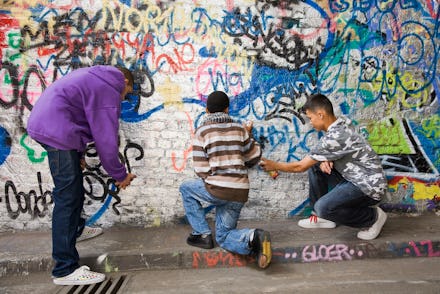A Millennial's Guide to the Broken Policy Putting Thousands of Inner-City Kids in Prison

The commissioner of the New York Police Department thinks millennials are too young to understand the social science behind stopping millions of innocent minority New Yorkers and frisking them for no reason.
"They did not experience the New York of 1990," Commissioner Bill Bratton, New York City's top law enforcement officer, told radio host/grocery billionaire John Catsimatidis during a recent interview. "They're experiencing the New York of 2015, which is a beautiful city, a safe city. That population group [was] not even alive, many of them, in 1990 when this city was going to hell in a handbasket."
Bratton was responding to a recent Quinnipiac University poll that showed voters 18 to 34 years old disapprove of the department's "broken windows" policy, a policing strategy that the city's law enforcement apparatus has clung to since the "bad old days" when the world's greatest city was overrun by C.H.U.D.s and sewer alligators. The controversial criminological theory posits that harsh crackdowns on small crimes such as vandalism and jumping subway turnstiles — crimes that lead to "broken windows" — create a cultural atmosphere of lawfulness, discouraging people from committing more serious crimes.
"Window-breaking does not necessarily occur on a large scale because some areas are inhabited by determined window-breakers whereas others are populated by window-lovers," said the authors of a 1982 Atlantic piece that brought the theory to the attention of the public. "Rather, one unrepaired broken window is a signal that no one cares, and so breaking more windows costs nothing."
Unfortunately for the theory's proponents, including self-described "America's Top Cop" Bratton and former New York City Mayor Rudy Giuliani, the theory is largely bullshit. Instead of lowering crime rates and turning the mean streets of New York into a Disney-fied playground for the world's wealthiest 1%, the implementation of harsh punishments for victimless crimes has created a climate of fear for the urban poor. For those of us who Bratton thinks are too focused on Snapchat and artisanal gastropubs, here's a primer on the policy — and the dangerous repercussions of treating graffiti artists like potential murderers.
"Broken windows" doesn't reduce crime rates. The theory, which was popularized by a landmark New Yorker piece penned by pop-psychology icon Malcolm Gladwell, became one of the most well-known social theories on crime. The highflown pop-psych roots of broken windows sold draconian police tactics to liberal politicians and city residents, and armed them with social science to counter accusations that they were soft on crime.
And no municipality embraced the idea more fervently than New York City. After Giuliani made Bratton commissioner in 1994, adversarial interactions between police and civilians became the new normal. That same year, the NYPD implemented CompStat, an approach to crime that included carrying out operations in accordance with the broken window theory — including heavy policing in areas with high rates of petty crime, the collection of data on criminals for profiling purposes and the eventual implementation of "stop and frisk." This last policy became so popular with the department that 685,724 people were subjected to it in 2011, according to the New York Civil Liberties Union. The majority of were black, and roughly 9 in 10 were innocent.
As the city's once high murder rate began to fall, Bratton and Giuliani were hailed as heroes who had finally vanquished urban crime in the wake of the crack epidemic. Bratton was on the cover of Time magazine, photographed on the so-clean-you-can-eat-off-them streets of Giuliani's New York with a squad car in the background.
But data revealed in the years after CompStat's implementation have shown that the violent crime rate in the city dropped at the same rate as it did in the rest of the country — including in cities that hadn't declared war on their own citizens over petty crime. Researchers at the University of Chicago and the University of Michigan even found that crime, rather than stemming from "disorder," was actually caused by the same root social and economic factors. In short, Gladwell, Giuliani and the rest of America had confused correlation with causation.
But "broken windows" is effective at one thing: sending thousands of young black men to jail. According to an essay by Bernard E. Harcourt of the University of Chicago and Jens Ludwig of Georgetown University, targeting petty crimes like graffiti and turnstile-hopping with heavy policing disproportionately harms blacks, Latinos and other racial and economic minorities.
In their delightfully titled "Reefer Madness: Broken Windows Policing and Misdemeanor Marijuana Arrests in New York City, 1989-2000," the implementation of CompStat led to a disproportionate number of drug arrests for blacks. From 1993, the year before its implementation, to 2000, misdemeanor arrests for marijuana possession and smoking in public jumped from 10 per year to an average of 644 per year. Although African-Americans only made up 25% of the city's population at the time, and use marijuana at similar rates to whites, they accounted for more than half of the arrests.
In another study published by the duo, the authors declared that because "broken windows" antagonized minority communities and alienated them from law enforcement, the policy may have even helped contribute to the underreporting of crime and was not "the optimal use of scarce law enforcement resources."
As thousands of minority New Yorkers are shepherded into its overcrowded, often dangerous jail system, it's important to note the force that helped put them there is based on pseudoscience. Following the July 2014 chokehold death of Eric Garner at the hands of an NYPD officer who suspected him of selling loose cigarettes, a letter written by six members of New York's congressional delegation and sent to then-Attorney General Eric Holder got to the heart of the issue:
"Mr. Garner's death has taken place in the context of a 'broken windows' policing strategy that appears to target communities of color." The price, in that case, was Garner's life.